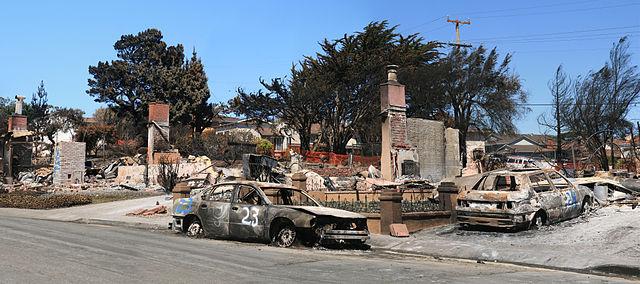
On September 9, 2010, a section of a natural gas pipeline exploded in San Bruno, just south of San Francisco. The blast killed eight people, injured 58 and destroyed 38 homes. Almost six years later, a federal jury found the utility guilty of five counts of safety violations and one count of obstruction of justice. According to Bloomberg, however, the maximum fine that Pacific Gas & Electric (PG&E) faces could be at most $3 million, far less than 1 percent of the $526 million than prosecutors sought during the trial and a fraction of the $1.13 billion fine originally considered by the U.S. government.
In a public statement, PG&E said, “While we are very much focused on the future, we will never forget the lessons of the past.” But an overview of the company’s behavior in the aftermath of the San Bruno explosion reveals an organization that was more concerned with covering up lax oversight and saving money rather than conducting itself as a responsible company. As described by the Los Angeles Times, PG&E executives lied to federal investigators about the standards the company had used to pinpoint high-risk pipelines so that it would not have to undertake more time-consuming and expensive tests.
A National Transportation Safety Board (NTSB) investigation found that PG&E had a history of poor quality control related to this pipeline, going as far back as the 1950s. One year after the deadly San Bruno explosion, an NTSB report accused PG&E of running a “deficient and ineffective” pipeline safety program that had numerous flaws. Among the problems were incomplete and inaccurate records; a failure to detect cracks when evaluating the structural integrity of this pipeline; and a series of internal assessments within PG&E that were “superficial and resulted in no improvements.”
The NTSB also savaged PG&E for taking 95 minutes to stop the flow of natural gas and isolate the site of the rupture. While the report lauded the quick response of local first responders, its authors found that PG&E lacked any detailed and comprehensive procedure allowing it to deal with an emergency of this scope, had no clear internal command structure who could lead during such a crisis and was saddled by a data system that made it difficult to gauge the exact location of the pipeline’s rupture.
While PG&E continues to describe the San Bruno explosion as an accident, the city of 42,000 and its mayor, Jim Ruane, have accused PG&E of trying to absolve itself of any responsibility. “It was an entirely man-made disaster,” the city said in a press release, “one that resulted from negligent decision making and actions by PG&E corporate executives over six decades and from the failure of the California Public Utilities Commission to protect our safety.”
Last year, the California Public Utilities Commission (CPUC), which was also criticized for allegedly poor oversight of the San Bruno pipeline, fined PG&E $1.6 billion for the unsafe operation of the utility’s entire natural gas transmission system. PG&E started paying off the fine by selling stock to finance the payments. In the meantime, state legislators in Sacramento have called for a complete restructuring and decentralization of the CPUC. State assembly members and senators have said that the San Bruno explosions and disasters such as the Aliso Canyon gas leak in the San Fernando Valley have shown that the regulator is inefficient and ineffective the way it is currently organized.
PG&E has said that it has spent $2.7 billion in shareholder funds to bolster the safety of its natural gas transmission system. But what the company does not reveal is that the incompetence of some of its executives has had a far reaching impact far beyond places such as San Bruno and Aliso Canyon.
PG&E's stock is held in a bevy of pension funds, including CALPERS, the foundation of the California’s state employee retirement system. Over the years many shareholders have invested in the company in the belief that utility stocks are safe. This can be justified by the company’s overall stock performance over the last several years, but changes in how the state will generate electricity in the coming decades will have an impact on a company that is only another crisis away from seeing its financial performance, and stock, both tank.
PG&E has a track record of being tone deaf to the concerns of its shareholders and stakeholders, as when California regulators had to intervene five years ago to ensure ratepayers would not be on the hook for a $10 million bonus the company awarded for a retiring CEO. One would think the company would be more attuned to the public’s concerns over its environmental stewardship and safety. After all, this was the company that was the inspiration of Erin Brockovich’s story, which was told in a 2000 movie about the company’s contamination of the local water in the Mojave Desert town of Hinkley. Although the company lists a long portfolio of actions describing it as a trusted community partner, the outcome of the San Bruno litigation shows that PG&E has a long way to go before it can truly portray itself as a responsible, people-oriented company.
Image credit: Brocken Inaglory/Wiki Commons

Leon Kaye has written for 3p since 2010 and become executive editor in 2018. His previous work includes writing for the Guardian as well as other online and print publications. In addition, he's worked in sales executive roles within technology and financial research companies, as well as for a public relations firm, for which he consulted with one of the globe’s leading sustainability initiatives. Currently living in Central California, he’s traveled to 70-plus countries and has lived and worked in South Korea, the United Arab Emirates and Uruguay.
Leon’s an alum of Fresno State, the University of Maryland, Baltimore County and the University of Southern California's Marshall Business School. He enjoys traveling abroad as well as exploring California’s Central Coast and the Sierra Nevadas.














